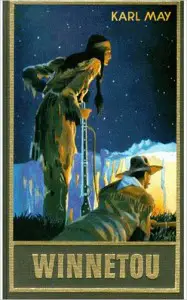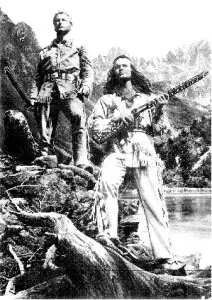 One of the best young adult novels also wildly enjoyed by grown-ups is Karl May’s Winnetou, to which one could add its two sequels Winnetou II and Winnetou III. Just like The Last of the Mohicans by James Fenimore Cooper, as a child, I read Winnetou in an abridged edition and thoroughly enjoyed Harld Reinl’s adaptations of the trilogy (1963, 1964, 1965). Nevertheless, many years after I had read and watched Winnetou, I almost completely forgot what the story was about. I could only recall the names of the two main characters, Old Shatterhand and Winnetou, and that these two childhood heroes of mine were involved in adventures on the American prairies.
One of the best young adult novels also wildly enjoyed by grown-ups is Karl May’s Winnetou, to which one could add its two sequels Winnetou II and Winnetou III. Just like The Last of the Mohicans by James Fenimore Cooper, as a child, I read Winnetou in an abridged edition and thoroughly enjoyed Harld Reinl’s adaptations of the trilogy (1963, 1964, 1965). Nevertheless, many years after I had read and watched Winnetou, I almost completely forgot what the story was about. I could only recall the names of the two main characters, Old Shatterhand and Winnetou, and that these two childhood heroes of mine were involved in adventures on the American prairies.
The first novel in the Winnetou trilogy is divided into two volumes, totaling over 700 pages and, hence, my decision, while still a child, to read the abridged version. But when I found it on the shelves of a second hand book store in Bangkok, I couldn’t resist the temptation and bought it with the intention of re-reading it in the near future. Now that I finished the first volume, I’ve decided to take a break from Old Shatterhand’s adventures and read something a bit more serious.
The first volume follows the changes a young German tutor stationed in St. Loius undergoes to become a seasoned man of the Wild West. Although not named until the second half of the volume, the hero, the future Old Shatterhand, proves to be the perfect warrior who can easily kill a charging buffalo with just one shot, a grizzly bear with just one knife, and, above all, can knock down anyone with just one blow to the head.
Setting in the Wild West as a surveyor for a railway company, Old Shatterhand, Karl May’s alter ego, befriends three palefaces, among whom Sam Hawkens becomes his teacher in matters of the survival skills one needed in the prairies of the West. But, soon the reader realizes that Old Shatterhand is too much of a man for Sam to have anything to teach him. By the end of volume one, the ‘greenhorn’ nicknamed Old Shatterhand becomes an experienced man who ends up rescuing his teacher from the murdering hands of the Kiowas, a nation of American Indians who represent the bad guys.
After many adventures and quite a few misunderstandings, Old Shatterhand becomes best friends and blood brother of Winnetou, a young chieftain of the Apaches. When Winnetou’s father and sister are killed by a white bandit, a party of Indians led by Winnetou and the three palefaces led by Old Shatterhand follow in pursuit only to run again into the Kiowa Indians who interfere with their plans of revenge. The first volume ends with Winnetou and Old Shatterhand being separated, each one with a different mission to accomplish. But, Karl May makes sure that the reader understands that the two friends will meet again in the second volume.
Regardless of its lengths, Karl May’s Winnetou is a very easy book to read. Unfortunately, for the adult reader, the writing style is too naïve, with the author explaining everything in great detail, even when the reader can easily understand the situation from the context. This was one of the main reasons why I found the book quite boring, but luckily, the novel is packed with action sequences that keep the reader hooked to the text, even though one can predict exactly what’s going to happen next.
I am inclined to believe that today, the Winnetou trilogy is not as popular with the young generation as it used to be twenty years ago. Still, I warmly recommend it to any teenager who’s into adventure books and has an interest in “Red Indians” and cowboy stories.
Photo source


Ah, one of my very first awakenings to slash fiction – the “blood brothers” part. I found the closeness between the two characters very moving as a young adult, but I was the only one of my class who ever read the suggested reading list for the summer holiday. I tried to explain to my classmates that these books were really fun, because of the adventure and the inner emotions I was experiencing on account of character closeness. Some of them indulged me but could not relate to what I was saying.